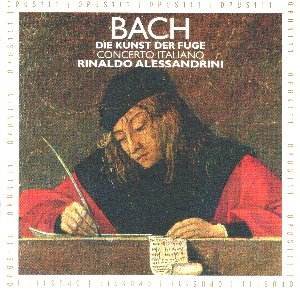Johann Sebastien BACH
Art of Fugue, BWV1080
Concerto Italiano - Rinaldo Alessandrini
OPUS 111 OPS 30-191 [74.27]
recorded digitally in Frascati, Italy, June
1998.
Crotchet

Although issued first in 1999, this disc is now re-issued at mid price in
a small Bach collection from OPUS111. Some of the other issues in this series
have been less than revelatory, but this one is excellent. Past performances
of the Art of Fugue have been done in a variety of ways, determined principally
by the objectives of the artists concerned. We have therefore had harpsichord,
piano, organ and orchestral (string quartet, chamber and full) versions issued
at one time or another over the years.
Some of these have sounded very academic (substitute dry if you wish) which
is fine, if you are studying the work. What most of us want I suspect however,
is a disc which we can listen to for pleasure. With a work like The Art of
Fugue this invariably means listening to variety, since we are listening
to the same material re-worked over and over again.
Concerto Italiano is a period instrument ensemble, and the instrumental content
of the group is as follows: Flute, Oboe, Oboe d'amore, oboe da caccia, bassoon,
violin, viola, cello and harpsichord. Rinaldo Alessandrini directs the group
from the harpsichord.
Each of the 20 sections of the work is entrusted to different combinations
of these instruments, and although there is some duplication, this is spread
through the work to make sure that no two movements following each other
are played by the same instrumental group. The four canons are entrusted
to the harpsichord alone.
Phrasing is very vital, and the rhythms continually lift so ensuring that
the listener doesn't notice the passing of time. This is really the way to
play this work, which is often seen as sometimes no more than an exercise
in showing Bach's expertise in the development of the fugue and counterpoint.
How did the Art of Fugue come about? In June 1746, Bach was accepted as a
member of the Correspondence Society for the furtherance of Musical Science,
which was founded in 1738 by his pupil Lorenz Christoph Mizler. It lasted
until 1755, and was made up of some twenty individuals, theoreticians and
practising musicians. Other members of this group included Handel and Teleman.
Its rules stipulated that each year, members should prepare and present
scientific papers or compositions with scientific contents. Bach's contributions
were the Canonic Variations BWV 769 in 1747, The Musical Offering, BWV 1079
in 1748. There is evidence that he intended to submit the Art of Fugue in
1749, but died before completing it in 1750.
The name was not on the original manuscript, and this was added later, probably
the inspiration of his son, C.P.E. Bach. To complete the unfinished manuscript
which was missing one item, some of Bach's friends decided to insert a
contrapuntal development of the Chorale BWV 668 which had been dictated by
Bach. It was a fitting tribute to the composer's skill in producing an academic
study which has become much more than that. The current performance should
be heard by all who love this music
Reviewer
John Phillips

